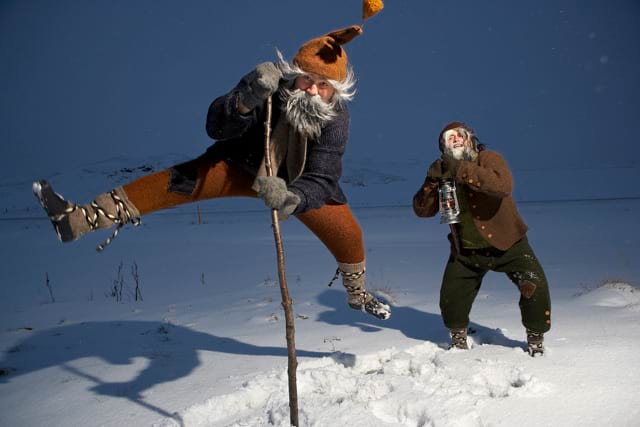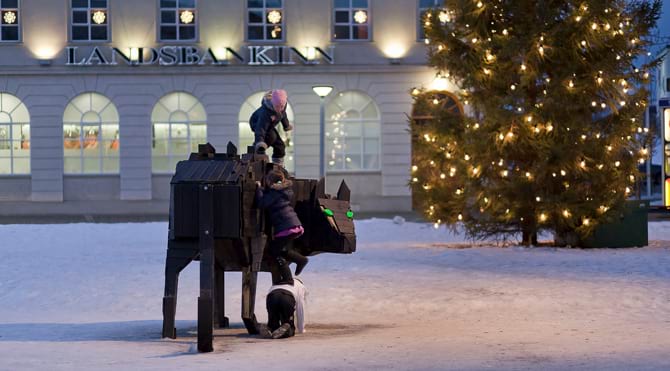The Yule Lads and Iceland’s Festive Folklore
When you visit Iceland at Christmas, you’ll soon find out that there’s more than one Santa here - in fact, there are thirteen of them!
The Yule Lads (Jólasveinar) are a unique feature of the Christmas celebrations in Iceland, a mischievous mob of troublesome trolls who roam the streets at this time of year.
Iceland’s festive folklore is filled with mountain-dwelling monsters and spooky characters, and the Yule Lads are part of a fearsome family of ogres and trolls.
Deeply rooted in the Icelandic storytelling tradition, the Yule Lads were more often thought of as “bogeymen” and used to scare children into better behavior.
Nowadays, the Yule Lads are much more friendly and an integral part of the Christmas countdown in Iceland, leaving little gifts in shoes on window sills on each of the thirteen nights leading up to Christmas Day.
Here’s everything you need to know about the Yule Lads and more about Iceland’s fascinating festive folklore!

Where do the Yule Lads come from?
The Yule Lads are the sons of Grýla, a scary giant ogress with an appetite for naughty children, and her third husband, Leppalúði, a lazy troll who rarely leaves their mountain cave at Dimmuborgir in North Iceland.
There are at least thirteen Yule Lads, who all have their own characters and ways of harassing and annoying the human population of Iceland around Christmastime.
Their names describe their favorite method of meddling with people - Spoon Licker, Door Slammer, and Sausage Stealer, for example.
The Yule Lads were first mentioned in the 17th-century Poem of Grýla and were considered creatures to be feared and avoided.
Over a hundred years later, another poem mentioned the Yule Lads. That inspired an Icelandic author called Jón Árnason to add them to his 1862 collection of local folk stories, the Icelandic equivalent of Grimms’ Fairytales.
Some sources suggest that there were as many as 70 different Yule Lads!
Seventy years later, the Icelandic poet Jóhannes úr Kötlum published a popular poetry book called Christmas is Coming (Jólin Koma).
Kötlum’s poem “The Yule Lads” established the names and characters of the famous thirteen Yule Lads we know today, beautifully illustrated for the first time by Tryggvi Magnússon.
Jólin Koma quickly became part of Iceland’s Christmas traditions, and is still one of the country’s most cherished books, and the Yule Lads began their journey from fearsome ogres to festive friends.
Instead of kidnapping naughty children, they’re now depicted in medieval Icelandic clothing and behaving more like Santa Claus, bringing treats for them.
Children are encouraged to place one of their shoes on a window sill, hoping for a little gift each night in the days leading up to Christmas, like a pair of socks or sweets.
But if the child has been naughty, the shoe will be filled with old or rotten potatoes instead!
The Christmas Cat
Adding to this frightening family is the Yule Cat, a monstrous feline who feeds on anyone unlucky enough to be caught wearing old clothes at Christmas.
Jóhannes úr Kötlum made the Yule Cat an equally famous feature in Iceland’s Christmas traditions with a poem called Jólakötturinn.
Depicted with bright yellow eyes and sharp teeth, Jólakötturinn would prowl the streets in search of anyone who wasn’t wearing new clothes on Christmas Eve.
The poem’s message was to encourage everyone to work hard the month before the holidays and earn enough money to afford fresh clothes to avoid being devoured by a mythical giant angry cat!

When do the Yule Lads arrive?
Starting on the night of December 11th, one after another, the Yule Lads will arrive and remain at their chosen location for thirteen nights before leaving, one by one, by January 6th.
December 12th: Stekkjarstaur - “Stiff Legs” or Sheep-Cote Clod
Stekkjarstaur has long, stiff legs and chases sheep on farms to get their milk but finds it a bit tricky because of his awkward legs.
December 13th: Giljagaur - “Gully Gawk”
Giljagaur hides in gullies and ravines around town, then steals milk from cowsheds whenever the farmhands aren’t looking.
December 14th: Stúfur - “Stubby”
Stúfur is small and short - he steals pots and pans and eats the crusty leftovers stuck to the bottom and the brims.
December 15th: Þvörusleikir - “Spoon Licker”
Þvörusleikir steals unwashed wooden stirring spoons, which he licks clean. He’s known for being very thin!
December 16th: Pottaskefill - “Pot Scraper”
Pottaskefill distracts people by knocking at their door, stealing unwashed pots, and looking for food scraps.
December 17th: Askasleikir - “Bowl Licker”
Askasleikir copies his brother, looking under beds for any unattended food bowls left for dogs and cats, which he then licks clean himself.
December 18th: Hurðaskellir - “Door Slammer”
Hurðaskellir enjoys slamming any doors left ajar whenever people are trying to take a nap, keeping the whole household awake.
December 19th: Skyrgámur - “Skyr Gobbler”
Skyrgámur loves skyr, the traditional Icelandic dairy product similar to yogurt, stealing it from the pantry whenever he gets the chance.
December 20th: Bjúgnakrækir - “Sausage Swiper”
Bjúgnakrækir climbs into the rafters to snatch sausages hung up there for smoking.
December 21st: Gluggagægir - “Window Peeper”
Gluggagægir lurks outside the house, peeking through any open windows, and looking for things to steal.
December 22nd: Gáttaþefur - “Door Sniffer”
Gáttaþefur has an enormous nose and sniffs out places where people are baking leaf bread, then steals any unguarded cakes and cookies.
December 23rd: Ketkrókur - “Meat Hook”
Ketkrókur uses a long hook to steal any hanging meat (hangikjöt)
December 24th: Kertasníkir - “Candle Stealer”
Kertasníkir steals candles from children, which were once very valuable objects in Iceland.
You’ll notice that the Yule Lads are very focused on food, reflecting harsher times in Iceland when making the most of your supplies was vitally important.
Some people say that one Yule Lad stays at one farm or location for all of Christmas.
Imagine having your doors slammed every day for Christmas!
The Yule Lads will return to their mountain home in Dimmuborgir (Dark Castles) in North Iceland from Christmas Day onwards.
New Year’s Eve
The bonfires and fireworks of New Year’s Eve also help drive away the Yule Lads and any otherworldly beings lingering after Christmas.
Families may encourage their departure by leaving out parting gifts as a gesture of farewell and goodwill.
Þrettándinn
Each Yule Lad leaves the human realm one by one until the last one departs on January 6th, also known as Þrettándinn.
Þrettándinn is the official end of Iceland’s Yuletide festivities (Jólin) and the last day when fireworks can be set off, or Christmas beers can be purchased.
It translates as the “Thirteenth,” a reference to the 13th day of festivities since Christmas Eve when people must prepare to return to work or school.
The night is marked by more bonfires, family parties, and communal gatherings, after which Yuletide decorations must be taken down to avoid the risk of bad luck for the year ahead.
Icelanders love a party, and the “Thirteenth” is often thought of as a “second New Year’s Eve” so expect lots of parties on this date!
The “weirdness” of the days after Christmas and New Year is underlined when you realize that January 6th was the “old date” for Christmas until the change to the Gregorian calendar moved it to December 25th.
January 6th is also a significant date in Icelandic folklore, when supernatural events may occur in plain sight.
That’s because Þrettándinn is one of four dates when Icelanders can make contact with the “hidden folk”.
Many Icelanders admit a belief in the Huldufólk - mystical beings, including elves, trolls, and fairies, who live in a parallel world alongside ordinary humans.
Elf bonfires (álfabrennur) are a popular part of the Þrettándinn festivities, with food left out and candles lit to encourage the elves to move on and find new homes.
Some communities elect Fairy Queens and Kings who lead “elf dances” around the bonfires, following a tradition set down in a 1907 play called Nýársnóttin (New Year’s Eve), which featured the King and Queen of the Elves.
In other villages, residents will walk around their homes asking for good luck from the spirits and saying goodbye to those who are moving from one place to another on this day.
The last Yule Lad to leave for the mountains is Kertasníkir, the Candle Beggar, who will hopefully have found enough to light his way home!
More unusually, one of Jón Árnason’s folk tales tells of cows who can suddenly stand and speak on the evening of January 6th, driving anyone who hears them completely mad!
And there’s more wild animal behavior this night - seals are said to take on human form on New Year’s Eve and Þrettándinn.
If you want to meet one of these mystical creatures, it’s considered best to sit at a crossroads and wait.
Elves will try to tempt you with various gifts, but if you can resist them until dawn, they have to leave all their treasures with you!
But if they catch your attention and you accept a gift from an elf before daylight on Þrettándinn, you may go mad. It’s up to you! Treat the elves well, and they will do the same for you.
Whatever happens in the supernatural world, Þrettándinn is the last day for a festive blow-out.
Icelanders will finish off all the leftovers, candles, and fireworks, making the most of their time with friends and family.
Iceland’s festive folklore may have some unusual elements, but some things are very much the same wherever you go!